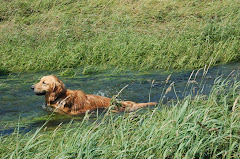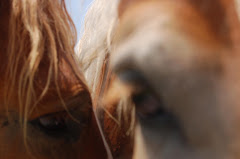My original intent was to write a blog about euthanasia. As I was gathering my thoughts, I reflected back on my feelings and emotions when I have had to euthanize one of my own pets. Because of this, I decided to write about my beloved Welsh Corgi, Ruby and tie this into the difficult topic of euthanasia and letting go........ Ruby
August 12, 1993-September 15, 2009
 This blog is both a tribute to my dog, Ruby and a lesson in aging, loving and letting go. I bought Ruby as an eight week old pup in October 1993. This was the first time I had owned a Corgi. She was a delight from the very beginning. She was easily house-broken and chewed very few belongings as a young pup. Ruby accompanied me to the clinic daily. She became our "Wal-Mart Greeter" for the equine clinic. She would come and go around the clinic, never seeming to be in the way or cause any trouble. Occassionally, her instinct to herd would erupt and she would assist us in loading a horse......now mind you, she would do this from a safe distance and just bark. In 1996, she did suffer a fractured pelvis from being kicked by a colt I was getting ready to castrate. I felt terrible.....she had to spend ~6 weeks confined to a cage.
This blog is both a tribute to my dog, Ruby and a lesson in aging, loving and letting go. I bought Ruby as an eight week old pup in October 1993. This was the first time I had owned a Corgi. She was a delight from the very beginning. She was easily house-broken and chewed very few belongings as a young pup. Ruby accompanied me to the clinic daily. She became our "Wal-Mart Greeter" for the equine clinic. She would come and go around the clinic, never seeming to be in the way or cause any trouble. Occassionally, her instinct to herd would erupt and she would assist us in loading a horse......now mind you, she would do this from a safe distance and just bark. In 1996, she did suffer a fractured pelvis from being kicked by a colt I was getting ready to castrate. I felt terrible.....she had to spend ~6 weeks confined to a cage.
Ruby loved the snow and winter. I remember reading in a Corgi newsletter how as a Corgi owner, one had to be careful that Corgis did not develop "intestinal chills" by laying on cold surfaces and because they were built "low to the ground". I chuckled about that article as I watched Ruby lay on ice and snow rather than be in the warmth of my office. Ruby's best friend was Dr. Linda's labrador retriever, Ben. While Ruby didn't seem to care much for other dogs, she loved Ben. They were best buddies. Ben often babysat for Ruby when I was out of town.
Ruby was a loyal companion.....she followed me willingly through a difficult period in my life when I seemed to be moving every 6 months. With each new residence, she would canvas the place, sniff and search, then make herself at home. She seemed to know.....long before I did....that this phase would end.....and all would be well. I could tell she wasn't too thrilled when Gordy joined the family and then Scoop.....but she accepted these additions with quiet stoicism.
Ruby began to slow down and start to show her age around 13 years. She would become disoriented and bark for no apparent reason. While she never would jump into my vehicle (she knew I'd pick her up), she was becoming reluctant to jump out. Radiographs showed arthritis in her hips and cervical spine. I started her on a non-steroidal anti-inflammatory, Metacam and the cognitive dysfunction medication, Anipryl. These daily medication helped her immensely and she showed her old spunk.
Then, about 6 months before her death, she developed idiopathic vestibular syndrome where she would lose her balance, listing and circling. She did recover somewhat from this episode but she just never seemed herself. Her appetite began to wan and I began hand feeding her. Towards the end of her days, she developed a cough. Thoracic radiographs revealed a mass. Caring for an elderly pet taught me alot about unconditional love, patience and duty. It also forced me to contemplate human aging and the passage of time.
When clients ask me...."when is it time?" to humanely euthanize their pet, I often tell them that they will know. The morning I euthanized Ruby, I knew it was time. She wouldn't eat, she hardly moved......and she looked at me. I could see in her eyes that she was ready. And while it broke my heart, I vowed to never let one of my pets suffer because I could not bear the pain. I euthanized Ruby surrounded by my husband, Gary and Dr. Linda. She was buried next to her boyfriend, Ben at Dr. Linda's farm.
There is much information written about grief and letting go.....and how to handle emotions and feelings after the fact. The time leading up to the decision to euthanize can be very difficult. The feelings of loss, pain and maybe guilt often deter us from letting go. My belief and philosphy is that it is a final gift that we can give our four legged friends by not allowing them to suffer. Whether it be a terminal disease, a castastrophic injury or natural aging changes, I truly believe it is our duty not to let them suffer. I am a big believer in quality of life......I read somewhere it is better to let them go one week too early, than one day too late. I believe that. God bless Ruby and all of our four legged friends.
In closing, I will reprint this anonymous letter:
A Dog's Plea
Treat me gently, my beloved friend, for no heart in the world is more grateful for kindness than mine. Speak to me often, for your voice is the world's sweetest music, as I will remind you by the fierce wagging of my tail when your footstep falls upon my waiting ear.
Do not break my spirit with a stick. Though I will forgive your every human shortcoming, your patience and understanding will more quickly teach me the things you would have me learn. In return, I will rejuvenate your heart and soul by sharing with you the simpler pleasures in life.
When it is cold and wet, take me inside, for I am domesticated and no longer accustomed to the bitter elements. Keep my pan filled with fresh food and water, for though in my youth, I may appear invincible, I depend on you for my very survival.
I ask no greater glory than the privilege of being a member of your family.
I will offer you companionship and unconditional love and make you smile in your bleakest hour. I will stand by your side, ready, willing and able to protect you with my life, should you be in danger.
But when my body or mind fails me or my injuries are too severe, please remember the things that have brought me pleasure. My sense of loyalty will drive me to go on living but I do not expect you to take heroic measures to support me or to sacrifice your own needs to care for me.
You may have to make the difficult decision to let me go before nature would take me. I understand the pain you will feel but trust you who love me most to decide what is best one last time. Please let me go while my dignity is still intact and see that my life is taken gently. Carry no guilt or remorse and be at peace with your decision. I shall leave this earth knowing with the last breath I draw that my fate was always safest in your hands.
Author Unknown
 This blog is both a tribute to my dog, Ruby and a lesson in aging, loving and letting go. I bought Ruby as an eight week old pup in October 1993. This was the first time I had owned a Corgi. She was a delight from the very beginning. She was easily house-broken and chewed very few belongings as a young pup. Ruby accompanied me to the clinic daily. She became our "Wal-Mart Greeter" for the equine clinic. She would come and go around the clinic, never seeming to be in the way or cause any trouble. Occassionally, her instinct to herd would erupt and she would assist us in loading a horse......now mind you, she would do this from a safe distance and just bark. In 1996, she did suffer a fractured pelvis from being kicked by a colt I was getting ready to castrate. I felt terrible.....she had to spend ~6 weeks confined to a cage.
This blog is both a tribute to my dog, Ruby and a lesson in aging, loving and letting go. I bought Ruby as an eight week old pup in October 1993. This was the first time I had owned a Corgi. She was a delight from the very beginning. She was easily house-broken and chewed very few belongings as a young pup. Ruby accompanied me to the clinic daily. She became our "Wal-Mart Greeter" for the equine clinic. She would come and go around the clinic, never seeming to be in the way or cause any trouble. Occassionally, her instinct to herd would erupt and she would assist us in loading a horse......now mind you, she would do this from a safe distance and just bark. In 1996, she did suffer a fractured pelvis from being kicked by a colt I was getting ready to castrate. I felt terrible.....she had to spend ~6 weeks confined to a cage. 














